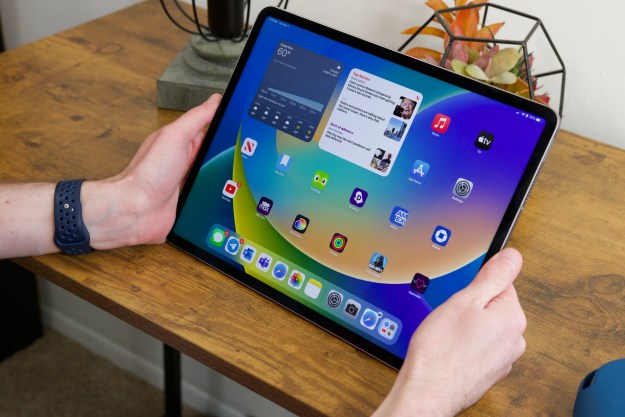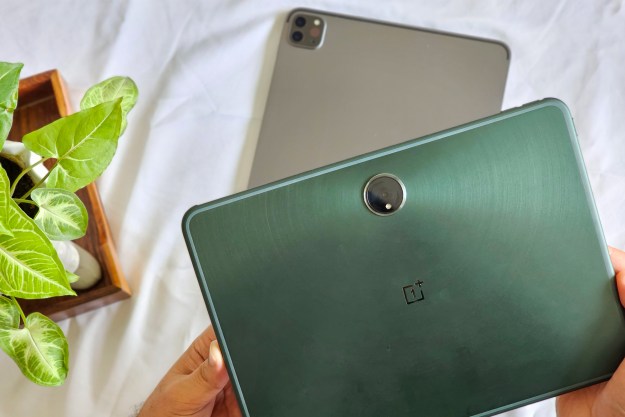Update on October 29, 2015: Adobe has made its Slate app available as a Web-based tool, in addition to the iPad app. And, both versions can sync up via a user’s Creative Cloud account, allowing you to start a project on one platform and finish it on the other.
Adobe today introduced Slate, a new, free image and text-based storytelling app for the iPad. The app, which lets users quickly create and publish content to the Web, complements Adobe’s Voice app that launched last year.
“Where Voice helps you take narration to record an animated video, Slate aims to help you take your written words and images to create a visual story that can be viewed on any device,” says Brian Nemhauser, director of Product Management at Adobe. “If you have photos and you want to wrap a story around those photos, Slate is a great tool for that.”
Whether it’s a school report, newsletter, or magazine, the app simplifies the Website-creation process – image search, page layout, typography, and coding – into a WYSIWYG process that’s all done entirely through the app. The app guides the user through the easy process of building a project, and doesn’t require the user to have any design or website-creation experience. Ideal users include students, teachers, nonprofits, small business, corporate employees, and photographers – people who need to communicate to others, but may not have the resources, experience, time, or funds to create beautiful presentations.
And beautiful presentations are what you get. Slate lets you produce professional-quality content that would normally require a lot of time, using multiple complex applications. With preset themes, users can pick the ones that appeal to them; Slate then ensures all typography, photos, and styling are uniform (so it doesn’t look like a mix of crazy fonts and wrongly sized images that was created using Microsoft Word). All the user has to do is place and arrange images, type some captions and body text, and publish to the Adobe Slate site; each project gets a unique link that can be shared, and is viewable on any Web browser.
“You’re essentially creating Web content in a way that’s as simple as saving a document to your hard drive,” Nemhauser says.
Each project starts off with a cover, a title, and subtitle. (When you first launch the app, you are presented with an Explore screen that takes you to other published Slate projects that serve as samples and inspiration.) Finding an image is easy: You can use one from your iPad camera roll or shoot a new one. You can pull one from the cloud, either through Dropbox, Adobe Creative Cloud, or Adobe Lightroom. A cool feature is Slate’s ability to find public Creative Commons imagery; punch in a keyword and Slate will show you available photos, and it’ll even automatically credit the photographer. Scrolling through all the images can be tedious, however.

From there, you can build out your project by adding additional pages – organizing it by however way you want to tell the story. You can have a photo fill an entire page with minimal text, or half the page with long paragraphs. You can also display multiple photos in a grid, or just a page of text (although Slate is meant to be a visual storytelling app that revolves around photos). “Slate will look at the order and the number and orientation of those photos, and make some decisions on how to best lay those out,” including which photos you want to put at the forefront, Nemhauser says. If typing on the iPad screen is cumbersome, Slate supports voice dictation. You can add “action” buttons that link to other sites for more information or, if you’re a nonprofit or business, to “donate now” or “buy now.”
“It’s a fail-free environment,” Nemhauser says. “I’m not bombarded with a lot of questions and design decisions. I’m just asked to add my story, and [Slate} will make it look great.”
While Slate projects are made on an iPad, they can be viewed from any device. Using adaptable design, Slate ensures that each layout is scaled appropriately for the screen size, whether it’s a 15-inch laptop or 5-inch smartphone. As you’re creating your project, you can dictate a focal point of a particular photos, so Slate will ensure that part of the photo is presented on any device, in any orientation. However, depending on the image resolution, a photo could great on a mobile device, but not so on a desktop computer.
Built on Adobe’s HTML Animation Engine, a published Slate project employs parallax scrolling for a nifty and modern Web browsing effect. “We have a lot of headroom for the kinds of engaging experiences we can build out as we grow with the app,” Nemhauser says.
Overall, Slate is an intuitive app that’s easy to use, and projects, depending on how in-depth they are, are simple and quick to build and publish. For now, there are no collaborative tools, so you can’t share a project with another user unless he/she is using your iPad. It focuses on the individual, but hopefully Adobe will allow multiple users to work on a single Slate layout – perhaps through Creative Cloud. As Nemhauser says, the app will grow over time.
Although it’s based on HTML technology and it’s published online, Adobe stresses Slate isn’t a website building too – it’s far too limited and restrictive in what it can do; if you want a blog, there’s Tumblr for that. Slate is marketed as a storytelling tool where photos and words play a major role.
Slate, which was formerly known as Project Luca, has already been in use, in some form, for six months, but development began two years ago. Students use it to create visual reports; teachers create online-accessible reference material; nonprofits promote events; and corporate employees publish flyers and newsletters, or build presentations for their bosses. But Slate can be used by anyone and for any reason, like a photographer sharing his photos or a youth soccer team profiling its players. You could even start your own magazine that’s dedicated to a favorite hobby.
Adobe is now bringing it to the masses, and while there are already a lot of publishing platforms available to users, Nemhauser says there’s too much noise on the Web that’s easily lost; Slate is designed to give impactful communication to people with limited skills in tech and design, while utilizing the existing social networks they are already on.
“There’s 7,000 tweets and 78,000 Tumblr posts [per minute], and all this communication going on, it’s very noisy and a lot of this communication is throwaway, Nemhauser says. “When you have something important to say, you still have to break through this noise, and still have to compete on this level and still have to look good and feel natural in these different channels. Nobody asked us for another social network they have to manage, but what they asked us for are tools to help them create content that will carry their message in a way that’ll stand out, in the channels they already have.”
(This article was originally published on April 2, 2015.)
Editors' Recommendations
- Apple may announce new iPads next month. Here’s everything we expect
- The future of iPhone gaming is in trouble
- 17 iPhone apps I couldn’t live without in 2023
- These developers are doing something amazing with iPhone and iPad apps
- Apple used this free iPhone app to shoot Monday’s Scary Fast event


